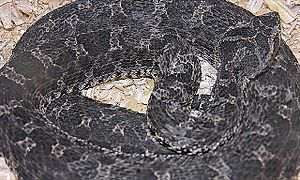Bothrops ammodytoides facts for kids
Bothrops ammodytoides is a type of venomous snake known as a pit viper. It lives only in Argentina. People often call it the Patagonian lancehead, yarará ñata, or Patagonian pit viper. No different types (subspecies) of this snake are known today.
Quick facts for kids Bothrops ammodytoides |
|
|---|---|
 |
|
| Scientific classification | |
| Genus: |
Bothrops
|
| Species: |
ammodytoides
|
| Synonyms | |
What it Looks Like
This snake has a strong, thick body. It usually grows to be about 45 to 75 centimeters (18 to 30 inches) long. Some can even reach almost 1 meter (39 inches)!
Its snout (nose area) points upwards. This makes it look a bit like other snakes called hog-nosed pitvipers. The scale on its nose, called the rostral scale, is longer than it is wide.
The snake's back is usually light brown. It has a pattern of large, dark brown spots or stripes that look like squares. These spots are outlined in black. On some snakes, these markings might form a zigzag pattern. There's also a dark stripe behind each eye. Its belly is yellowish with small brown dots.
The scales on its back are very rough, like they have a ridge (a "keel") in the middle. There are 23 or 25 rows of these scales around the middle of its body. The top of its head is covered in small, rough scales that overlap like roof tiles.
Where it Lives
The Patagonian lancehead is found only in Argentina. It lives in many different provinces, including Buenos Aires, Catamarca, Córdoba, Chubut, La Pampa, La Rioja, Mendoza, Neuquén, Río Negro, San Juan, San Luis, Santa Cruz, and Tucumán.
It can be found from sea level all the way up to at least 2,000 meters (about 6,500 feet) high in the mountains. This snake lives further south than almost any other snake in the world!
Its Home (Habitat)
This snake likes dry places. It lives in warm or mild savannas (grassy plains with scattered trees) and steppes (dry, grassy lands). You can often find it in sandy or rocky areas, like coastal dunes, steep riverbanks, and salt flats. When it lives in higher, colder areas, it might sometimes be found in evergreen forests.
See also
 In Spanish: Bothrops ammodytoides para niños
In Spanish: Bothrops ammodytoides para niños 

